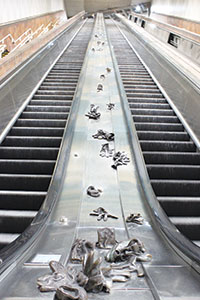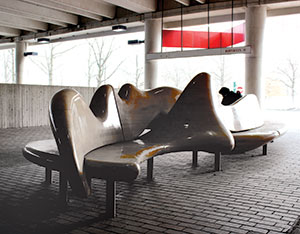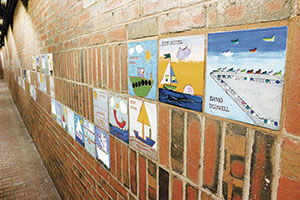
Porter Square Station: “Glove Cycle” by Mags Harries.
By Claire Felter
On a large projector screen in a dimmed conference room is a two-dimensional visual of the future Washington Street T Station in Somerville. The image displays a brand new gallery, a hallway clear of the grime that collects over time in older subway stations. There is something else absent as well, though. Several hologram-like people placed into the picture stare at a stark white wall – an allusion to the filling of these blank panels with artwork when the station is constructed in several years’ time.
“There are opportunities for art and some really unique architecture,” Karen Arpino-Schaffer said to a roomful of artists both young and old.
Schaffer is deputy program manager for HDR/Gilbane, the program and construction management team for the MBTA’s Green Line Extension (GLX).
The Feb. 6 information session where these station visuals were displayed was one of the first steps for the GLX Arts Commission Project, which will procure several artists to help design art for the new stations. The MBTA’s design team gave an overview of plans for the new Washington Street, Union Square and Lechmere stations and identified for artists potential spots where their works could be incorporated.
MBTA Director of Design and Architecture Marggie Lackner said there had been interest in including an artistic aspect from the beginning stages of the Green Line Extension project.
“When we were having early community meetings throughout the corridor, a number of people, many of whom represented arts organizations, made it clear that they wanted to have art somehow involved with the project,” Lackner said during a phone interview.

Alewife Station: Maple, stainless steel sculptural bench (1 of 2) done by William Keyser, Jr.
Lackner’s team didn’t know, though, if funds would be allocated towards an arts project. In December, Secretary of Massachusetts Department of Transportation Richard Davey made the announcement that 0.5 percent of construction cost of the new stations, estimated at $225,000, was to be dedicated to the arts. Lackner and her colleagues had already drafted an integrated art policy that conformed to Federal Transit Authority guidelines, so once they received notice that funds would be available, the team drew up a request for qualifications to bring a few artists on to the team. A selection committee will choose up to three artists, each of who will receive a portion of the budget as compensation for his/her work.
Joe Barillaro, an artist and Somerville resident, is one of the applicants vying for a spot on the design team. No stranger to public art, Barillaro has done two large-scale murals in Somerville parks, and he repurposed an old phone box in Davis Square as part of a Somerville Arts Council project.
“I have been able to branch out and do a little public art,” Barillaro said. “It’s something I want to be able to dial up, but I usually have to do free or on a volunteer basis.”
Barillaro has made a living for the past 20 years by designing pieces for theatre and movie sets. He said he thought his extensive experience in set design could translate well to integrating art within larger structural elements.
“It sounded like something that would be up my alley,” he said.
In compliance with the integrated art policy written for the project, the art won’t be akin to pieces in a museum or sculptures found in parks or town squares. The works will only be enhancements to building features like lighting, fencing and paneling, which would already be required within the construction of the stations.
Similar projects can be seen in public transit systems all over the world in places such as Taiwan, Paris and Singapore. In 2012, the Memphis Area Transit Authority in Tennessee sought artists to design bus stop shelters.
With works by more than 150 artists, over 90 of Stockholm’s 100 subway stations are adorned with art. The city’s tourism site boasts that the transit system is the world’s longest art exhibit at 110 kilometers. The Metropolitan Transit Authority claims a similar feat on its site, stating that the New York City subway is the world’s largest art museum. The online Subway Art Guide shows 274 different works, all commissioned through New York City’s Arts for Transit program.
The GLX project isn’t even the first of its kind in Boston. In the late 1970s, the Cambridge Arts Council and MBTA received grants for a program entitled Arts on the Line, which would place contemporary works into subway stations that were part of the then-ongoing Red Line Extension. Twenty pieces of art were incorporated into the Harvard Square, Porter Square, Davis Square and Alewife stations. The program was later expanded to 12 more stations, according to the Harvard Square website, and the MBTA partnered with nonprofit UrbanArts in the 1980s to bring art to stations along the Orange Line.

Davis Square Station: Childrens’ Tile Mural by Jack Gregory and Joan Wye.
Despite the similarities to past initiatives, Lackner states that the process for creating the Arts Commission for the new Green Line stations has been quite different from the Arts on the Line project.
“The state required that there be a percent for art, and that’s how the Arts on the Line project happened,” Lackner said.
Without policy necessitating the use of federal funds for art, the push has to come from somewhere else – in this case, from heads like Secretary Davey who happen to be arts supporters.
Statements by project sponsors typically cite a desire to enhance the rider experience as the main reason for commissioning art in public transportation systems, but the question arises whether public art in spaces like transit stations has any real impact.
Ixia, a public art think tank based in Birmingham, England, conducted a 2012 survey of nearly 600 people and found that participants felt the most important role of public art lay in shaping local, regional and national identities.
Similar conclusions came out of a survey of approximately 43,000 people done by The Knight Foundation and Gallup, which found that an area’s aesthetics ranked in the top three qualities, along with openness and social offerings such as entertainment venues, which drive a person’s attachment to his or her community.
For Lackner, the only question was if the funding would come. There was never doubt about the project being beneficial to residents.
“Most people would like to have art in transit,” Lackner said, “and we just haven’t been able to do it for some time.”
Lackner was already envisioning a more subtle benefit for Green Line riders when she spoke to potential applicants at the information session.
“Not everyone will be reading the signs,” she said, “but maybe they can read the art and know that they’re home.”















Reader Comments